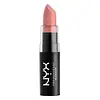What's inside
What's inside
 Key Ingredients
Key Ingredients

 Benefits
Benefits

 Concerns
Concerns

 Ingredients Side-by-side
Ingredients Side-by-side

Butter
Skin ConditioningBis-Diglyceryl Polyacyladipate-2
EmollientEthylhexyl Palmitate
EmollientIsopropyl Palmitate
EmollientOctyldodecanol
EmollientOleyl Alcohol
EmollientEuphorbia Cerifera Wax
Beeswax
Emulsion StabilisingHydrogenated Microcrystalline Wax
Emulsion StabilisingIsostearyl Isostearate
EmollientPolyisobutene
Ozokerite
Emulsion StabilisingPolyethylene
AbrasiveCopernicia Cerifera Wax
Tocopheryl Acetate
AntioxidantTocopherol
AntioxidantHydrogenated Palm Glycerides Citrate
EmollientAlumina
AbrasiveBHT
AntioxidantParfum
MaskingButter, Bis-Diglyceryl Polyacyladipate-2, Ethylhexyl Palmitate, Isopropyl Palmitate, Octyldodecanol, Oleyl Alcohol, Euphorbia Cerifera Wax, Beeswax, Hydrogenated Microcrystalline Wax, Isostearyl Isostearate, Polyisobutene, Ozokerite, Polyethylene, Copernicia Cerifera Wax, Tocopheryl Acetate, Tocopherol, Hydrogenated Palm Glycerides Citrate, Alumina, BHT, Parfum
Dimethicone
EmollientCaprylic/Capric Triglyceride
MaskingSilica
AbrasivePolyglyceryl-2 Triisostearate
EmulsifyingSynthetic Wax
AbrasiveCeresin
Emulsion StabilisingTitanium Dioxide
Cosmetic ColorantVinyl Dimethicone/Methicone Silsesquioxane Crosspolymer
CI 77491
Cosmetic ColorantDimethicone/Vinyl Dimethicone Crosspolymer
Skin ConditioningEthylene/Propylene Copolymer
AbrasivePolyhydroxystearic Acid
EmulsifyingCI 77499
Cosmetic ColorantTocopheryl Acetate
AntioxidantGlyceryl Caprylate
EmollientTriethoxycaprylylsilane
Ethylhexylglycerin
Skin ConditioningParfum
MaskingCI 15850
Cosmetic ColorantTocopherol
AntioxidantDimethicone, Caprylic/Capric Triglyceride, Silica, Polyglyceryl-2 Triisostearate, Synthetic Wax, Ceresin, Titanium Dioxide, Vinyl Dimethicone/Methicone Silsesquioxane Crosspolymer, CI 77491, Dimethicone/Vinyl Dimethicone Crosspolymer, Ethylene/Propylene Copolymer, Polyhydroxystearic Acid, CI 77499, Tocopheryl Acetate, Glyceryl Caprylate, Triethoxycaprylylsilane, Ethylhexylglycerin, Parfum, CI 15850, Tocopherol
Ingredients Explained
These ingredients are found in both products.
Ingredients higher up in an ingredient list are typically present in a larger amount.
Parfum is a catch-all term for an ingredient or more that is used to give a scent to products.
Also called "fragrance", this ingredient can be a blend of hundreds of chemicals or plant oils. This means every product with "fragrance" or "parfum" in the ingredients list is a different mixture.
For instance, Habanolide is a proprietary trade name for a specific aroma chemical. When used as a fragrance ingredient in cosmetics, most aroma chemicals fall under the broad labeling category of “FRAGRANCE” or “PARFUM” according to EU and US regulations.
The term 'parfum' or 'fragrance' is not regulated in many countries. In many cases, it is up to the brand to define this term.
For instance, many brands choose to label themselves as "fragrance-free" because they are not using synthetic fragrances. However, their products may still contain ingredients such as essential oils that are considered a fragrance by INCI standards.
One example is Calendula flower extract. Calendula is an essential oil that still imparts a scent or 'fragrance'.
Depending on the blend, the ingredients in the mixture can cause allergies and sensitivities on the skin. Some ingredients that are known EU allergens include linalool and citronellol.
Parfum can also be used to mask or cover an unpleasant scent.
The bottom line is: not all fragrances/parfum/ingredients are created equally. If you are worried about fragrances, we recommend taking a closer look at an ingredient. And of course, we always recommend speaking with a professional.
Learn more about ParfumTocopherol (also known as Vitamin E) is a common antioxidant used to help protect the skin from free-radicals and strengthen the skin barrier. It's also fat soluble - this means our skin is great at absorbing it.
Vitamin E also helps keep your natural skin lipids healthy. Your lipid skin barrier naturally consists of lipids, ceramides, and fatty acids. Vitamin E offers extra protection for your skin’s lipid barrier, keeping your skin healthy and nourished.
Another benefit is a bit of UV protection. Vitamin E helps reduce the damage caused by UVB rays. (It should not replace your sunscreen). Combining it with Vitamin C can decrease sunburned cells and hyperpigmentation after UV exposure.
You might have noticed Vitamin E + C often paired together. This is because it is great at stabilizing Vitamin C. Using the two together helps increase the effectiveness of both ingredients.
There are often claims that Vitamin E can reduce/prevent scarring, but these claims haven't been confirmed by scientific research.
Learn more about TocopherolTocopheryl Acetate is AKA Vitamin E. It is an antioxidant and protects your skin from free radicals. Free radicals damage the skin by breaking down collagen.
One study found using Tocopheryl Acetate with Vitamin C decreased the number of sunburned cells.
Tocopheryl Acetate is commonly found in both skincare and dietary supplements.
Learn more about Tocopheryl Acetate